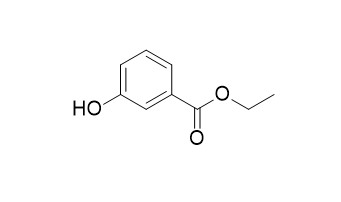Ethyl 3-hydroxybenzoate
Ethyl 3-hydroxybenzoate has antimycotic activity, it could as food-grade antimicrobial agents.
Inquire / Order:
manager@chemfaces.com
Technical Inquiries:
service@chemfaces.com
Tel:
+86-27-84237783
Fax:
+86-27-84254680
Address:
1 Building, No. 83, CheCheng Rd., Wuhan Economic and Technological Development Zone, Wuhan, Hubei 430056, PRC
Providing storage is as stated on the product vial and the vial is kept tightly sealed, the product can be stored for up to
24 months(2-8C).
Wherever possible, you should prepare and use solutions on the same day. However, if you need to make up stock solutions in advance, we recommend that you store the solution as aliquots in tightly sealed vials at -20C. Generally, these will be useable for up to two weeks. Before use, and prior to opening the vial we recommend that you allow your product to equilibrate to room temperature for at least 1 hour.
Need more advice on solubility, usage and handling? Please email to: service@chemfaces.com
The packaging of the product may have turned upside down during transportation, resulting in the natural compounds adhering to the neck or cap of the vial. take the vial out of its packaging and gently shake to let the compounds fall to the bottom of the vial. for liquid products, centrifuge at 200-500 RPM to gather the liquid at the bottom of the vial. try to avoid loss or contamination during handling.
J Pharm Biomed Anal.2021, 196:113931.
Molecules.2016, 21(10)
Int J Cosmet Sci.2019, 41(1):12-20
Int Immunopharmacol.2019, 71:22-31
Food Chem X.2024, 24:101989.
Front Endocrinol (Lausanne).2020, 11:568436.
VNU J Science: Med.&Pharm. Sci.2024.2588-1132
ARPN Journal of Eng.& Applied Sci.2016, 2199-2204
Industrial Crops and Products2018, 353-362
J Ethnopharmacol.2017, 209:305-316
Related and Featured Products
Journal of Advanced Oxidation Technologies, 2016,19(1):125-133.
Fenton’s Oxidation Kinetics, Pathway, and Toxicity Evaluation of Diethyl Phthalate in Aqueous Solution.[Reference:
WebLink]
A comprehensive study of the chemical oxidation degradation of diethyl phthalate (DEP) was conducted through Fenton processes.
METHODS AND RESULTS:
Effects of various operating parameters that considerably affect DEP decomposition were investigated, including solution pH, H2O2, Fe2+, and DEP concentration. The removal efficiency of DEP achieved 98% under reaction conditions of pH value of 3.0, concentration of 0.3 mM of Fe2+, and 6.0 mM of H2O2 after 170 min. In general, DEP degradation in Fenton process was found to occur in two stages, with an extremely fast stage and then a slow one, as a result of change of H2O2 and Fe2+ initial concentration. Based on the pseudo-steady-state hypothesis of hydroxyl radical formed by the Fenton reaction, a kinetic model for DEP degradation has been proposed which describes the effect of decomposition byproducts on the oxidation reaction. The experiment results also were in good agreement with Behnajady-Modirshahla-Ghanbery (BMG) kinetic model. During the degradation process, seven degradation intermediates of DEP were detected out by means of GC/MS, including ethyl 2-hydroxybenzoate, Ethyl 3-hydroxybenzoate, phthalic anhydride, benzoic acid ethyl ester, malonic acid, oxalic acid, and acetic acid. Probable degradation pathway of DEP by the Fenton reaction was also proposed. Inhibitory effects of DEP and intermediate products were investigated in aqueous solution with Photobacterium phosphoreum.
CONCLUSIONS:
Findings indicated that the solution was not completely detoxified even if DEP completely disappeared, further post-treatment was recommended. All these observations have significant potential applications and require further investigation.
International journal of food microbiology, 2009, 131(2-3):178-182.
In vitro antimycotic activity of a Williopsis saturnus killer protein against food spoilage yeasts.[Reference:
WebLink]
METHODS AND RESULTS:
The in vitro antimycotic activity of a purified killer protein (KT4561) secreted by a strain of Williopsis saturnus was tested against 310 yeast strains belonging to 21 food spoilage species of 14 genera (Candida, Debaryomyces, Dekkera, Hanseniaspora, Issatchenkia, Kazachstania, Kluyveromyces, Pichia, Rhodotorula, Saccharomyces, Schizosaccharomyces, Torulaspora, Yarrowia and Zygosaccharomyces). Minimum inhibitory concentration (MIC) determinations showed that over 65% of the target strains were susceptible to concentrations ≤ 32 µg/ml of KT4561. Three conventional food-grade antimicrobial agents were used as controls: 41, 33 and 40% of the target strains were sensitive to ≤ 512 mg/ml of Ethyl 3-hydroxybenzoate (E214), potassium sorbate (E202) or potassium metabisulphite (E224), respectively. The susceptibility of food spoilage yeasts towards KT4561, E214, E202 and E224 was species- and strain-dependent. In most cases KT4561 exhibited MIC values several orders of magnitude lower (100 to 100,000 times) than those observed for E214, E202 and E224. With only a few exceptions, the activity of KT4561 was pH-, ethanol-, glucose- and NaCl-independent.
CONCLUSIONS:
The present study demonstrates the potential of this yeast killer protein as a novel and natural control agent against food spoilage yeasts.



